- Joined
- Dec 3, 2022
- Messages
- 1,547
- Points
- 488

From the frequency of the updates you might think that Coquin is holding my interest. However, it wasn't delight that brought me to the playbench, WORKbench today but sheer bloody-mindedness. I have a feeling that if I take a day off, it will swiftly turn into an indefinite postponement and yet another unfinished project. Must. Keep. Going.
My reluctance to spend even a single week doing more or less the same thing 40 times over is something of a fatal flaw for a modeller of wooden boats. It's now clear to me that at least two of the models in my collection will never be built by me even if I live to a thousand. I have La Real, the Christian flagship at Lepanto, which is a galley with thousands of oars, seats etc. That's a Dusek kit. And there's Le Requin from ZHL which is a 1/48 scale plank on FRAME xebec kit with zillions of frames to build.

There was one delightful moment within the drudgery. That dark plank at the top of the picture fitted so well without glue or clamps (just the weight of the scalpel to hold it in place) that I had to take its portrait. Most of the strakes fit a little less well and it's only the hot setting technique that makes them so easy, or perhaps even possible to tack into place.
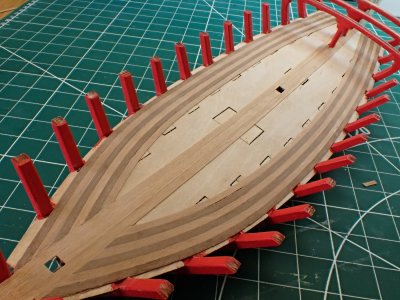
I have about half of the curved pieces laid now. I think the pattern will work aesthetically and emphasise the fish-like shape of the boat.
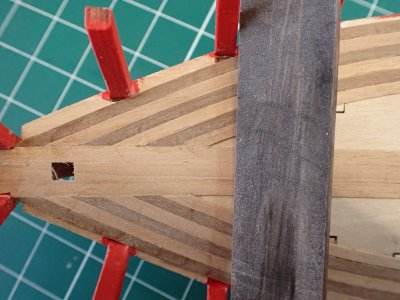
As I expected, the plank ends have slipped a little out of synchrony, though without the straight edge wedged in the bulkheads, it's not too obvious. Remember, the many gratings and some massive deck mounted structures will hide three quarters of all this.
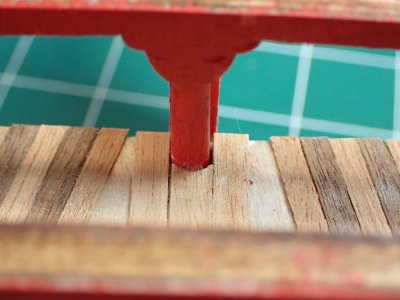
I've run out of room aft and will now have to make joints at both ends of the curved pieces. This will slow me down a bit but while the aft ends of the planks continue to terminate under the quarterdeck, they will be impossible to see clearly, so they don't need to be very good. Nor did the planks you see in the photo - hence the gaps. I'll fill the space with barrels if the pattern really falls apart. Come to think of it, I'll fill the space with barrels anyway. Yo-ho-ho and a big saving of effort!
My reluctance to spend even a single week doing more or less the same thing 40 times over is something of a fatal flaw for a modeller of wooden boats. It's now clear to me that at least two of the models in my collection will never be built by me even if I live to a thousand. I have La Real, the Christian flagship at Lepanto, which is a galley with thousands of oars, seats etc. That's a Dusek kit. And there's Le Requin from ZHL which is a 1/48 scale plank on FRAME xebec kit with zillions of frames to build.

There was one delightful moment within the drudgery. That dark plank at the top of the picture fitted so well without glue or clamps (just the weight of the scalpel to hold it in place) that I had to take its portrait. Most of the strakes fit a little less well and it's only the hot setting technique that makes them so easy, or perhaps even possible to tack into place.

I have about half of the curved pieces laid now. I think the pattern will work aesthetically and emphasise the fish-like shape of the boat.

As I expected, the plank ends have slipped a little out of synchrony, though without the straight edge wedged in the bulkheads, it's not too obvious. Remember, the many gratings and some massive deck mounted structures will hide three quarters of all this.

I've run out of room aft and will now have to make joints at both ends of the curved pieces. This will slow me down a bit but while the aft ends of the planks continue to terminate under the quarterdeck, they will be impossible to see clearly, so they don't need to be very good. Nor did the planks you see in the photo - hence the gaps. I'll fill the space with barrels if the pattern really falls apart. Come to think of it, I'll fill the space with barrels anyway. Yo-ho-ho and a big saving of effort!
Last edited:



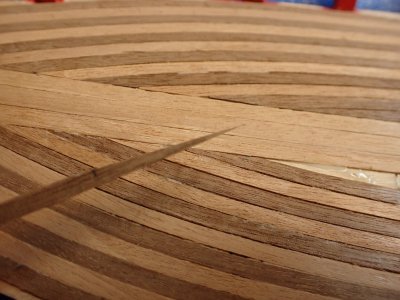
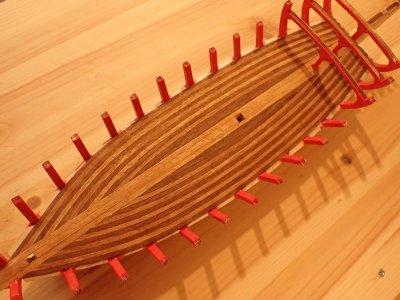























![P4190042[1].JPG P4190042[1].JPG](https://shipsofscale.com/sosforums/data/attachments/498/498400-c832878ac4035c5b6b089ff9100022ad.jpg?hash=B8inhpQtpR)
![P4190043[1].JPG P4190043[1].JPG](https://shipsofscale.com/sosforums/data/attachments/498/498457-5feb78ff38e1381ec6ad7f9897635f0a.jpg?hash=2gmXPpMbsr)